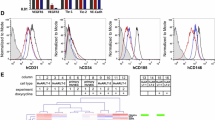Summary
SK-HEP-1 is an immortal, human cell line derived from the ascitic fluid of a patient with adenocarcinoma of the liver. We have determined that these cells are of endothelial origin. Despite the location of the tumor from which SK HEP-1 was derived, the cell line does not have properties of hepatocytes. Northern blot analysis of total cellular RNA shows no messenger RNA for the hepatic-specific proteins albumin, alpha-fibrinogen, or gamma-fibrinogen. Endothelial characteristics are seen by transmission electron microscopy. These features include numerous pinocytotic vesicles, electron dense granules consistent with Weibel-Palade bodies, and abundant intermediate filaments, identified immunocytochemically as vimentin. Cultures grown on plastic dishes grow in bundles of polygonal to spindle-shaped cells. Proteins characteristic for endothelial cells are identified by immunocytochemistry. Addition of basement membrane material (Matrigel) or type I collagen to the cultures induces these cells to organize into a tubular network.
Similar content being viewed by others
References
Alles, J. U.; Bosslet, K. Immunocytochemistry of angiosarcomas: a study of 19 cases with special emphasis on the applicability of endothelial cell specific markers to routinely prepared tissues. Am. J. Clin. Pathol. 89:463–471; 1988.
Bolyard, M. G.; Lord, S. T. High-level expression of a functional human fibrinogen gamma chain in Escherichia coli. Genen 66:183–192; 1988.
Brooimans, R. A.; Van der Ark, A. A. J.; Buurman, W. A., et al. Differential regulation of complement factor H and C3 production in human umbilical vein endothelial cells by IFN-gamma IL-1. J. Immunol. 144:3835–3840; 1990.
Carlson, R. I.; Ben-Porath, E.; Shouval, D., et al. Antigenic characterization of human hepatocellular carcinoma; development of in vitro and in vivo immunoassays that use monoclonal antibodies. J. Clin. Invest. 76:40–51; 1985.
Chirgwin, J. M.; Przybyla, A. E.; MacDonald, R. J., et al. Isolation of biologically active ribonucleic acid from sources enriched in ribonuclease. Biochemistry 18:5294–5299; 1979.
DeBruijn, M. H. L.; Fey, G. H. Human complement component C3: cDNA coding sequence and derived primary structure. Proc. Natl. Acad. Sci. USA 82:708–712; 1985.
Fogh, J.; Fogh, J. M.; Orfeo, T. One hundred and twenty-seven cultured human tumor cell lines producing tumors in nude mice. Journal of the National Cancer Institute 59:221–226; 1977.
Fogh, J.; Trempe, G. Human tumor cells in vitro. New York: Plenum Press; 1975.
Frank, W. W.; Schmid, E.; Winter, S., et al. Widespread occurrence of intermediate-sized filaments of the vimentin-type in cultured cells from diverse vertebrates. Exp. Cell Res. 123:24–46; 1979.
Glisin, V.; Crkyenjakev, R.; Byus, C. Ribonucleic acid isolation by cesium chloride centrifugation. Biochemistry 13:2633–2637; 1974.
Grant, D. S.; Tashiro, K.-I.; Sigui-Real, B., et al. Two different laminin domains mediate the differentiation of human endothelial cells into capillary-like structures in vitro. Cell 58:933–943; 1989.
Guarda, L. A.; Ordone, N. H.; Smith, J. L., et al. Immunoperoxidase localization of factor VIII in angiosarcomas. Arch. Pathol. Lab. Med. 106:515–516; 1982.
Jahn, L.; Fouguet, B.; Rohe, K., et al. Cytokeratins in certain endothelial and smooth muscle cells of two taxonomically district vertebrate species, Xenopus laevis and man. Differentiation 36:234–254; 1987.
Kant, J. A.; Loard, S. T.; Grabtree, G. R. Partial mRNA sequences for human A-alpha, B-beta, and gamma fibrinogen chains: evolutionary and functional implications. Proc. Natl. Acad. Sci. USA 80:3953–3957; 1983.
Kelly, J. H.; Darlington, G. J. Modulation of the liver specific phenotype in the human hepatoblastoma line Hep G2. In Vitro 25:217–222; 1989.
Kubota, Y.; Kleinman, H. K.; Martin, G. R., et al. Role of laminin and basement membrane in the morphological differentiation of human endothelial cells into capillary-like structures. J. Cell Biol. 107:1589–1598; 1988.
Little, D.; Said, J. W.; Siegel, R. J., et al. Endothelial cell markers in vascular neoplasms: an immunohistochemical study comparing factor VIII-related antigen, blood group specific antigens, 6 keto-PGF1 alpha, and ulex europaeus lectin. J. Pathol. 149:89–95; 1986.
Maciag, T.; Kadish, J.; Wilkins, L., et al. Organizational behavior of human umbilical vein endothelial cells. J. Cell Biol. 94:511–520; 1982.
Madri, J. A.; Williams, S. K. Capillary endothelial cell cultures: phenotypic modulation by matrix components. J. Cell Biol. 97:153–165; 1983.
Maniatis, T.; Fritsch, E. F.; Sambrook, J. Molecular cloning: a laboratory manual. Cold Spring Harbor: Cold Spring Harbor Laboratory; 1982:545.
Martin, G. R.; Timpl, R. Lminin and other basement membrane components. Ann. Rev. Cell Biol. 3:57–85; 1987.
Matteson, K. J.; Su, T. S.; O’Brien, W. E., et al. Preparation and screening of a human liver cDNA library. DNA (Abstract) 1:201; 1982.
Seabright, M. A rapid banding technique for human chromosomes. Lancet 2:971–971; 1971.
Shouval, D.; Eilat, D.; Carlson, R. I., et al. Human hepatoma-associated cells surface antigen: identification and characterization by means of monoclonal antibodies. Hepatology 5:347–356; 1985.
Shouval, D.; Schuger, L.; Levij, I. S., et al. Comparative morphology and tumorigenicity of human hepatocellular carcinoma cell lines in athymic rats and mice. Virchows Archiv. A. Path. Anat. & Histopath. 412:595–606; 1988.
Totsch, M.; Dobler, G.; Feichtinger, H., et al. Malignant hemangioendothelioma of the thyroid, its immunohistochemical discrimination from undifferentiated thyroid carcinoma. Am. J. Surg. Path. 14:69–74; 1990.
Turner, B. M.; Turner, V. S. Secretion of alpha-antitrypsin by an established human hepatoma cell line and by human/mouse hybrids. Somatic Cell Genetics 6:1–14; 1980.
Wick, M. R.; Manivel, J. C. Epithelioid sarcoma and epithelioid hemangioendothelioma: an immunocytochemical and lectin-histochemical comparison. Virchows Arch. A. 410:309–316; 1987.
Author information
Authors and Affiliations
Rights and permissions
About this article
Cite this article
Heffelfinger, S.C., Hawkins, H.H., Barrish, J. et al. SK HEP-1: A human cell line of endothelial origin. In Vitro Cell Dev Biol - Animal 28, 136–142 (1992). https://doi.org/10.1007/BF02631017
Received:
Accepted:
Issue Date:
DOI: https://doi.org/10.1007/BF02631017




